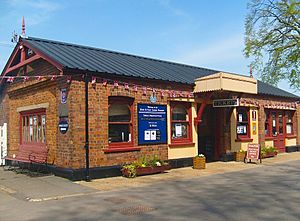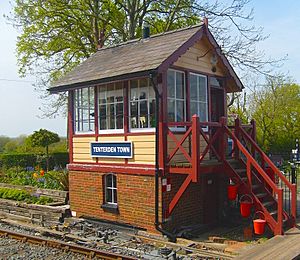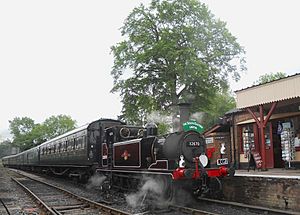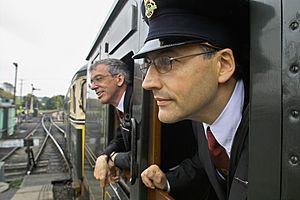Kent and East Sussex Railway facts for kids
Quick facts for kids Kent and East Sussex Railway |
|
|---|---|
| K&ESR, KESR | |
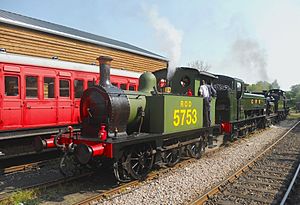
The grand cavalcade at Tenterden Town Station during a Steam Gala on the Kent and East Sussex Railway
|
|
| Locale | Kent East Sussex South East England |
| Terminus | Tenterden Town Bodiam |
| Commercial operations | |
| Built by | H. F. Stephens |
| Original gauge | 4 ft 8 1⁄2 in (1,435 mm) standard gauge |
| Preserved operations | |
| Owned by | Kent and East Sussex Railway |
| Operated by | Kent and East Sussex Railway |
| Stations | 5 |
| Length | 11.5 miles (18.5 km) |
| Preserved gauge | 4 ft 8 1⁄2 in (1,435 mm) standard gauge |
| Commercial history | |
| Opened | Freight: 26 March 1900 Passenger: 2 April 1900 |
| Closed to passengers | 4 January 1954 |
| Closed | 12 June 1961 |
| Preservation history | |
| 1974 | Partial re-opening |
| 1977 | Line extends and re-opened to Wittersham Road |
| 1990 | Line extends and re-opened to Northiam |
| 2000 | Line extends and re-opened to Bodiam |
| 2011 | Line extends to Junction Road Halt (no station built or planned, special events only) |
| Headquarters | Tenterden Town (main facility) Rolvenden (loco depot) |
The Kent and East Sussex Railway (K&ESR) is a special railway in Kent and East Sussex, England. It's known for two things: first, it was a real railway company that existed a long time ago. Second, it's now a fun heritage railway where you can ride old trains! The railway runs between Tenterden Town and Bodiam.
There's also another group, the Rother Valley Railway, working to bring back more of the old track. They are restoring the line between Robertsbridge Junction and Bodiam.
Contents
The Old Railway Company
How the Railway Started
Back in the mid-1800s, the town of Tenterden was surrounded by railway lines, but it didn't have its own direct connection. People tried many times to build a railway to Tenterden, but their plans didn't work out.
Then, in 1896, a new law called the Light Railways Act 1896 made it easier and cheaper to build smaller railways. A group of people from Tenterden, led by Myles Fenton, decided to build a line from Robertsbridge to Tenterden. They called it the Rother Valley Railway.
A very important person named Holman F Stephens (later known as Colonel Stephens) was in charge of building and running the railway. He was known for building many "light railways" across the country.
Opening and Growing Up
The railway was built using simpler methods, which meant trains couldn't go super fast. At first, they were limited to 15 miles per hour (24 km/h), but this was soon increased to 25 miles per hour (40 km/h).
The line first opened for freight (carrying goods) on March 26, 1900, and for passengers on April 2, 1900. The first station for Tenterden was actually about 2 miles (3.2 km) away from the town.
On April 15, 1903, the railway extended right into Tenterden Town. The old Tenterden station was then renamed Rolvenden. In 1904, the Rother Valley Railway changed its name to the Kent & East Sussex Light Railway. The line continued to grow, reaching Headcorn on May 15, 1905.
During World War I (1914-1918) and World War II (1939-1945), the K&ESR was used by the government to help with the war effort. It was an important route for supplies.
Changes and Closing Down
After the wars, the railway faced challenges. More people started using cars and buses, so fewer passengers rode the trains. In 1948, the K&ESR became part of a bigger national railway system called British Railways.
Even with new management, passenger numbers kept falling. The last regular passenger train ran on January 2, 1954. Freight trains continued for a few more years, and special trains for hop-pickers ran until 1958.
The very last train to run on the line before it closed completely was a special tour on June 11, 1961. The railway officially closed the next day, on June 12, 1961. A small part of the line near Robertsbridge stayed open for a flour mill until January 1, 1970.
How the Trains Ran
The Kent & East Sussex Light Railway was run in two main parts: Robertsbridge to Tenterden Town, and Tenterden Town to Headcorn. The section to Headcorn had stronger tracks, so heavier locomotives could be used there.
At first, the railway ran separate trains for passengers and goods. But by the 1920s, they often ran "mixed trains" that carried both. They even tried out special railbuses, which were lighter and cheaper to run.
During the hop-picking season, special trains brought many people from London to help pick hops. These trains could be quite long! Tickets were usually bought right on the train.
Railway Accidents
Even small railways can have accidents. Here are a few that happened on the K&ESR:
- In 1916, a locomotive called Hesperus got stuck and derailed in a deep snowdrift.
- On January 9, 1929, a Ford railmotor (a small train powered by a car engine) went off the tracks at Junction Road.
- In March 1949, a steam engine (No. 32678) derailed between Northiam and the Rother Bridge. It took a month to get it back on the tracks!
- In May 1983, a preserved steam engine called 'Charwelton' derailed, damaging the track and the locomotive.
Bringing the Railway Back to Life
Preservation History
After the railway closed, people immediately started working to save it. It took some time, but in 1974, part of the line reopened as a heritage steam railway between Tenterden and Rolvenden.
Over the years, the railway slowly grew longer:
- It reached Wittersham Road in 1977.
- It extended to Northiam in 1990.
- It finally reached Bodiam in 2000.
- In 2011, an extra one mile (1.6 km) of track was added to the site of Junction Road halt.
The preserved railway has faced some tough times, including money problems. But it has always managed to keep going, thanks to dedicated volunteers and staff. They also hold special events to earn money and keep the railway running.
Because the original railway was built cheaply, the preserved railway has had to do a lot of work to fix and improve the tracks and bridges. For example, in 1990, they had to remove part of an embankment that badgers had damaged!
The Railway Today
Today, the Kent and East Sussex Railway is a popular place for tourists. You can enjoy an 11+1⁄2 miles (18.5 km) ride through the beautiful Rother Valley. Most of the time, you'll ride in old-fashioned coaches pulled by a steam locomotive. Sometimes, a diesel train is used for off-peak services.
The preserved line runs from Tenterden Town station all the way to Bodiam, where you can even see the famous Bodiam Castle. The track also goes a bit further to the Junction Road station site, but trains don't stop there for passengers yet.
Tenterden Town station is the main hub for the railway. Here you'll find a gift shop, a cafe, and the carriage and wagon workshop. The locomotive workshop is at Rolvenden station, where you can often see engines being repaired.
The railway hosts many fun events throughout the year. These include special days with Thomas the Tank Engine and Santa specials, which are very popular with families. You can even try a "railway experience day" to see what it's like to work on the line!
Colonel Stephens Railway Museum
At Tenterden, you can visit the Colonel Stephens Railway Museum. This museum tells the story of Colonel Stephens and the many light railways he built. It has interesting exhibits, including a wax figure of the Colonel himself! Many children enjoy looking at the old railway magazines and timetables.
Rother Valley Railway
At Robertsbridge, a separate group called the Rother Valley Railway is working to restore more of the old line. Their goal is to reconnect Robertsbridge with Bodiam.
They have made good progress, laying new track and building a new station platform at Robertsbridge. In 2016, they even reconnected their line to the main national railway network!
There are still some challenges, like crossing a main road and buying land from owners who don't want to sell. But in May 2023, they received important permission (a Transport and Works Act order) to rebuild and operate the rest of the line. This means they are closer to their dream of linking up with the Kent and East Sussex Railway at Bodiam.
Trains and Carriages
Old Locomotives and Railcars
The original Kent & East Sussex Railway used various steam locomotives and railcars. Some were bought new, while others were purchased second-hand from bigger railway companies.
- Steam Locomotives: Early engines included Tenterden and Northiam. Later, they had engines like Bodiam (a small "Terrier" tank engine) and Hecate. Many of these older engines were scrapped over time.
- Railcars: These were smaller, lighter vehicles, some powered by steam and others by petrol (gasoline). They were cheaper to run than full trains.
Hired Locomotives
Sometimes, the K&ESR would borrow or hire locomotives from larger railway companies, especially when their own engines needed repairs or during busy times. These included different types of steam engines from the Southern Railway.
Passenger Carriages
The railway had a mix of passenger carriages. Some were new when the line opened, while others were bought second-hand. They had different types, from small 4-wheel carriages to larger ones. Some were even rebuilt from older carriages.
Freight Wagons
The K&ESR also had wagons for carrying goods, like open wagons and cattle wagons. They also had a brake van, which was used by the guard at the back of the train.
Non-Rail Vehicles
The railway also owned vehicles that didn't run on tracks!
- Horse Bus: Built in 1902, this bus carried passengers before cars were common. It's now preserved at the National Railway Museum in York.
- Lorries: In the 1930s, the railway bought two Bedford lorries to help transport goods, replacing their horse-drawn vans.
British Railways Era Trains
After 1948, when the K&ESR became part of British Railways, different locomotives worked on the line until its closure in 1961. These included "Terrier" steam engines, O1 class steam engines, and even some early diesel locomotives.
Heritage Railway Trains
The preserved Kent & East Sussex Railway has its own collection of historic trains. These include various steam locomotives and diesel engines, as well as passenger carriages from different eras, allowing visitors to experience what train travel was like in the past.
Railway Friends Across the Sea
The Kent & East Sussex Railway has a special friendship with another preserved railway in France, called the Chemin de Fer de la Baie de Somme. This is called "twinning." Sometimes, K&ESR locomotives even visit their twin railway in France!
The Railway in Books
The Kent & East Sussex Railway has inspired writers. It appears in the 1924 book A Parcel of Kent by F J Harvey Darton. It's also featured in the 1940 book Ember Lane by Sheila Kaye-Smith, where it's called the Sussex Border Railway. There's even a poem about it called Farmer's Train by Hugh Bevan.
Images for kids


